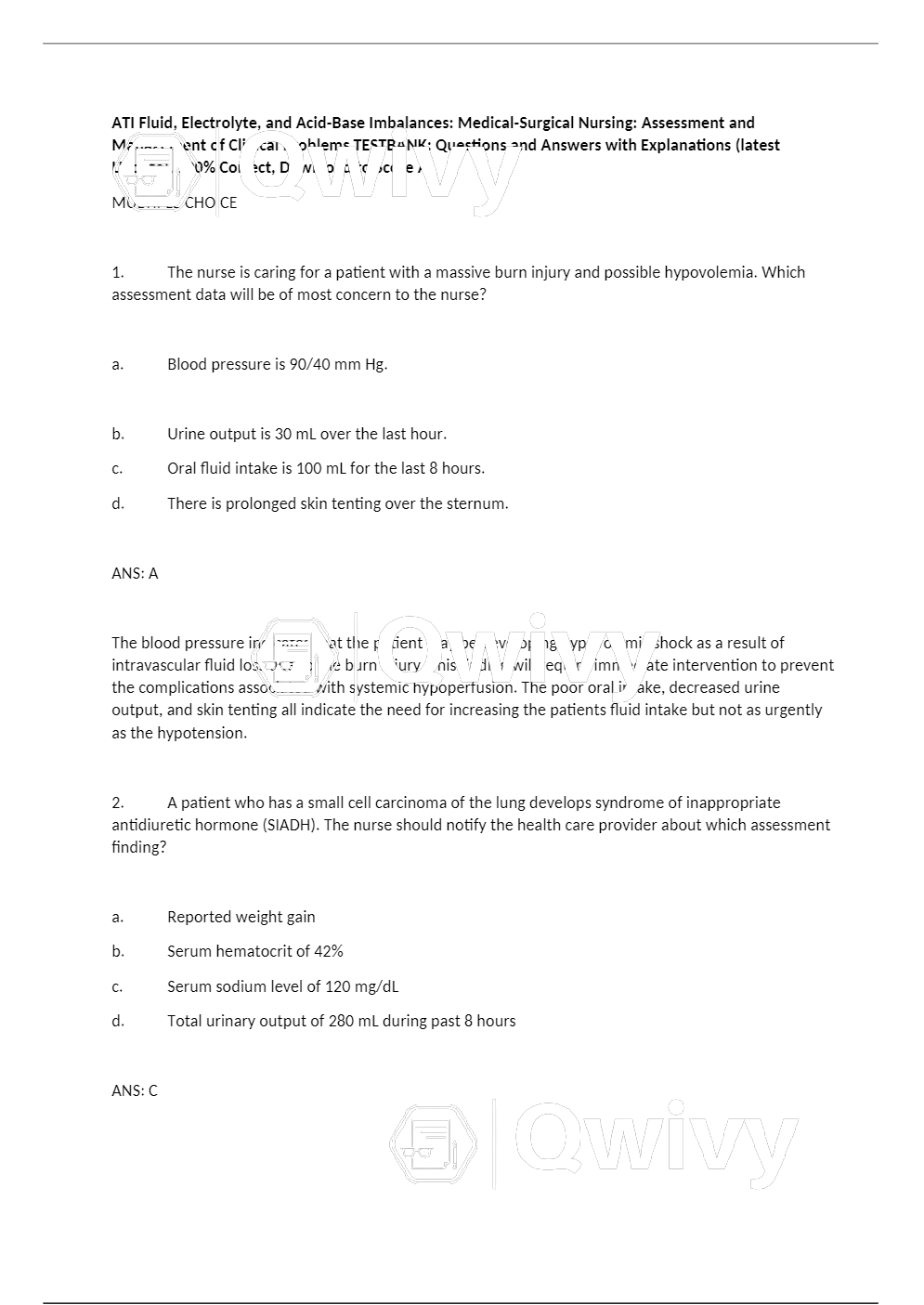
ATI Fluid, Electrolyte, and Acid-Base Imbalances: Medical-Surgical Nursing: Assessment and
Management of Clinical Problems TESTBANK: Questions and Answers with Explanations (latest
Update), 100% Correct, Download to Score A
MULTIPLE CHOICE
1. The nurse is caring for a patient with a massive burn injury and possible hypovolemia. Which
assessment data will be of most concern to the nurse?
a. Blood pressure is 90/40 mm Hg.
b. Urine output is 30 mL over the last hour.
c. Oral fluid intake is 100 mL for the last 8 hours.
d. There is prolonged skin tenting over the sternum.
ANS: A
The blood pressure indicates that the patient may be developing hypovolemic shock as a result of
intravascular fluid loss due to the burn injury. This finding will require immediate intervention to prevent
the complications associated with systemic hypoperfusion. The poor oral intake, decreased urine
output, and skin tenting all indicate the need for increasing the patients fluid intake but not as urgently
as the hypotension.
2. A patient who has a small cell carcinoma of the lung develops syndrome of inappropriate
antidiuretic hormone (SIADH). The nurse should notify the health care provider about which assessment
finding?
a. Reported weight gain
b. Serum hematocrit of 42%
c. Serum sodium level of 120 mg/dL
d. Total urinary output of 280 mL during past 8 hours
ANS: C
Hyponatremia is the most important finding to report. SIADH causes water retention and a decrease in
serum sodium level. Hyponatremia can cause confusion and other central nervous system effects. A
critically low value likely needs to be treated. At least 30 mL/hr of urine output indicates adequate
kidney function. The hematocrit level is normal. Weight gain is expected with SIADH because of water
retention.
3. A patient is admitted for hypovolemia associated with multiple draining wounds. Which
assessment would be the most accurate way for the nurse to evaluate fluid balance?
a. Skin turgor
b. Daily weight
c. Presence of edema
d. Hourly urine output
ANS: B
Daily weight is the most easily obtained and accurate means of assessing volume status. Skin turgor
varies considerably with age. Considerable excess fluid volume may be present before fluid moves into
the interstitial space and causes edema.
Although very important, hourly urine outputs do not take account of fluid intake or of fluid loss through
insensible loss, sweating, or loss from the gastrointestinal tract or wounds.
4. The home health nurse cares for an alert and oriented older adult patient with a history of
dehydration. Which instructions should the nurse give to this patient related to fluid intake?
a. Increase fluids if your mouth feels dry.
b. More fluids are needed if you feel thirsty.
c. Drink more fluids in the late evening hours.
d. If you feel lethargic or confused, you need more to drink.
ANS: A
An alert, older patient will be able to self-assess for signs of oral dryness such as thick oral secretions or
dry-appearing mucosa. The thirst mechanism decreases with age and is not an accurate indicator of
volume depletion. Many older patients prefer to restrict fluids slightly in the evening to improve sleep
quality. The patient will not be likely to notice and act appropriately when changes in level of
consciousness occur.
5. A patient who is taking a potassium-wasting diuretic for treatment of hypertension complains of
generalized weakness. It is most appropriate for the nurse to take which action?
a. Assess for facial muscle spasms.
b. Ask the patient about loose stools.
c. Suggest that the patient avoid orange juice with meals.
d. Ask the health care provider to order a basic metabolic panel.
ANS: D
Generalized weakness is a manifestation of hypokalemia. After the health care provider orders the
metabolic panel, the nurse should check the potassium level. Facial muscle spasms might occur with
hypocalcemia. Orange juice is high in potassium and would be advisable to drink if the patient was
hypokalemic. Loose stools are associated with hyperkalemia.
6. Spironolactone (Aldactone), an aldosterone antagonist, is prescribed for a patient. Which
statement by the patient indicates that the teaching about this medication has been effective?
a. I will try to drink at least 8 glasses of water every day.
b. I will use a salt substitute to decrease my sodium intake.
c. I will increase my intake of potassium-containing foods.
d. I will drink apple juice instead of orange juice for breakfast.
ANS: D
Powered by qwivy(www.qwivy.org)
| Version | 2022 |
| Category | ATI |
| Included files | |
| Authors | qwivy.com |
| Pages | 13 |
| Tags | ATI Fluid Electrolyte and Acid-Base Imbalances: Medical-Surgical Nursing: Assessment and Management of Clinical Problems TESTBANK: Questions and Answers with Explanations (latest Update) 100% Correct Download to Score A |
| Comments | 0 |
| Sales | 0 |









{{ userMessage }}





